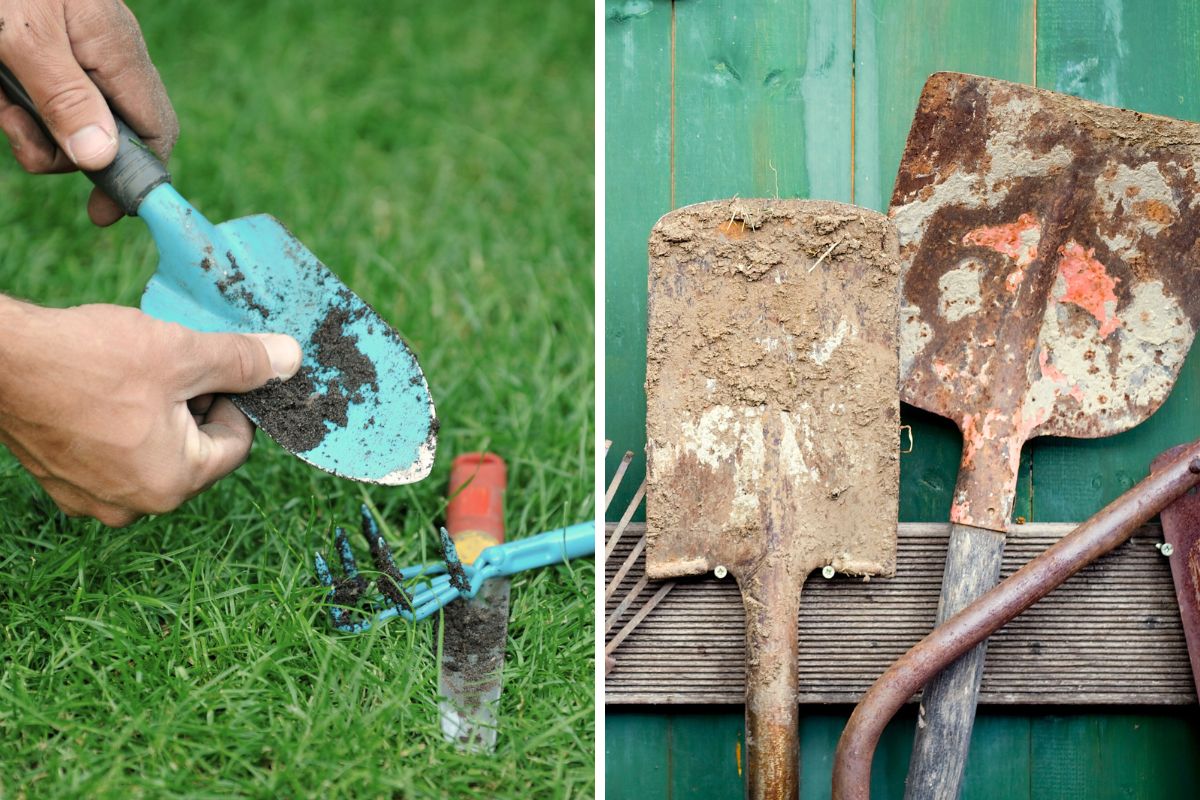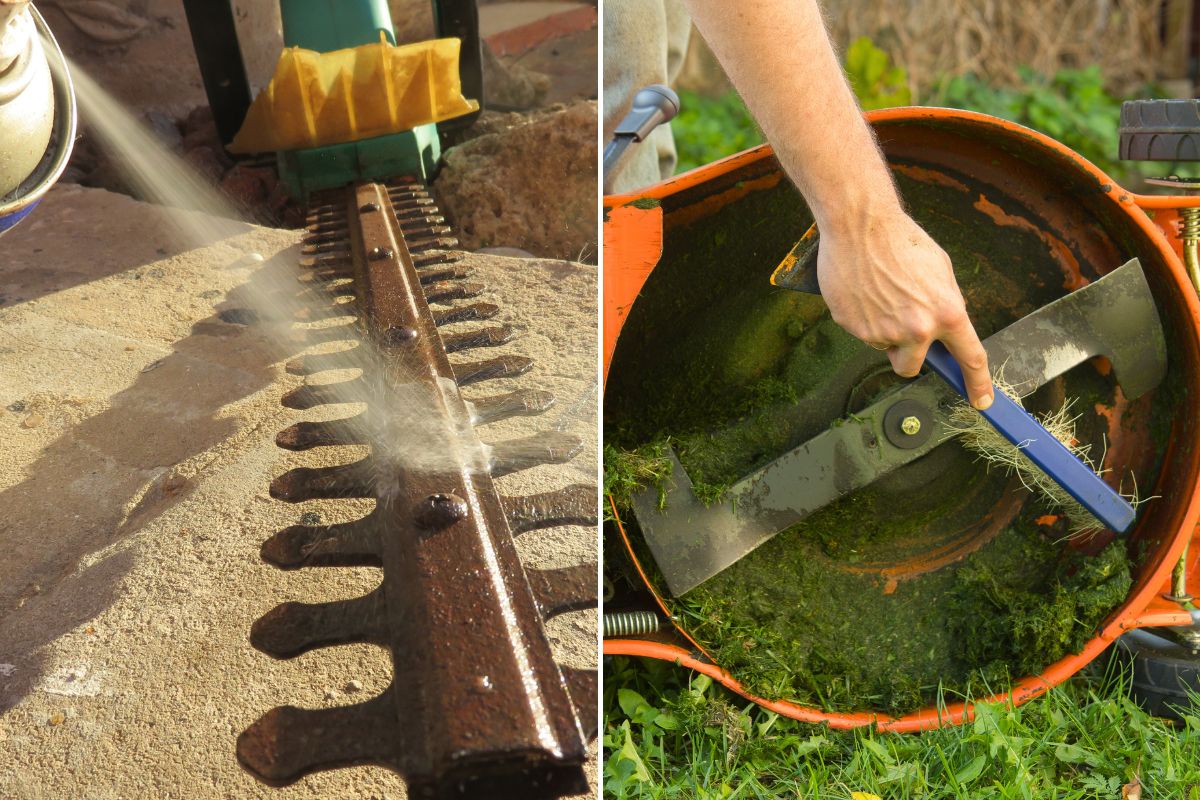Garden tools are the backbone of every garden. Shovels, rakes, secateurs, and even motorised equipment like hedge trimmers or lawnmowers each have a specialised purpose to aid you in your garden experience. However, if these tools are old, worn, and dull, they can turn an enjoyable task into an arduous chore.
No matter which tool you have in your shed, let’s look at how to maintain, clean, oil, and sharpen your garden tools to keep them in peak performance.
The Benefits of Looking After Your Garden Tools
Whether you are dealing with hand tools like shovels, pruners or snippers, hoes, rakes, or other power tools like chainsaws, hedge trimmers, and weed eaters, there are many reasons to keep your tools clean, sharp, and in good working order.
Some of the benefits of maintaining your garden tools include:
- Plant Hygiene: Cleaning and disinfecting tools prevents the spread of disease
- Safety: Sharp tools are easier to use and won’t slip unpredictably and cause injury
- Clean Pruning: Cuts from sharp secateurs heal faster and better
- Rust-free: Clean and dry tools are less likely to rust
- Longevity: Properly caring for your tools means they will last a long time (sometimes even for generations!)
- Enjoyment: Using well-maintained tools increases our enjoyment of gardening and the likelihood that we will get out there and tackle the gardening jobs
Seasonal Tool Maintenance
In many cases, caring for our tools can be a simple task of wiping them clean and putting them back in their proper place each time we are done with them. But when the lists of garden tasks start to pile up, we often neglect our tools and sometimes years will go by before we give them the TLC they desperately need.
No matter how busy we get, the best times to maintain garden tools are:
- When they are dirty or dull
- Throughout the growing season to keep in peak condition
- When putting them away in the autumn
- After working with contaminated plants or soil
- After working in someone else’s garden (to avoid spreading weeds and disease)
How to Care for Hand Tools
For many of us, hand tools are essential implements that help us keep our gardens growing beautifully. It’s only fair to give them the care they require.
Follow these steps to take care of your hand tools throughout the season:
1. Remove Dirt and Debris
The first step is to remove dirt, mud, and organic matter that might stick to your tools. Not only can this debris scratch finer surfaces, but it can also hold moisture and cause rust, both of which will decrease the effectiveness and lifespan of the tool.
Remove dirt and debris from hand tools by:
- Spraying with a garden hose
- Soaking and washing in a bucket of soapy water (regular dish soap works fine)
- Using a metal scraper such as an old putty knife or stiff wire brush (work carefully so as not to damage any sharpened edges)
 Remove dirt and debris from garden tools before storing
Remove dirt and debris from garden tools before storing
2. Remove Sticky Residue
Sometimes, tools will get a buildup of sap or grease. It is important to clean this off as it can blunt the edges or interfere with the mechanisms of the tool (such as with secateurs or pruners).
Rubbing alcohol effectively removes sticky residue, as does orange oil or other commercial products. Lighter fluid is also a common and effective product, but handling this flammable liquid should be done with extreme caution.
3. Disinfecting
Washing tools with soap might not kill pathogens, so it is important to sanitise your tools, especially after working with diseased plants, or if your tools were used somewhere outside your garden.
To disinfect tools, simply rub them down with 70% rubbing alcohol (isopropyl alcohol) or an alcohol-based sanitising solution.
Caution: Bleach is often recommended as a sanitising solution, especially for large batches of tools, but exposure to this chemical can corrode metal and reduce the sharp edges of your tools.
4. Dry Tools Before Putting Them Away
Tools will rust and the handles can get mouldy if they are left wet or damp for too long. Make sure to dry wet tools with a towel or put them in the hot sun to dry before putting them away.
5. Rust Removal and Prevention
Even with the best of care, metal tools can develop rust. Sometimes, long forgotten tools can be so rusty they need great attention before they can be used.
Rust can be removed by scouring the surfaces with steel wool or a stiff wire brush. Once the rust is removed, apply a thin coat of oil to protect the metal. Natural oils to choose from include:
- Linseed oil
- Tung oil
- Mineral oil
- Coconut oil
These oils provide superior protection without becoming rancid. Many sources suggest using motor oil, but this introduces undesirable chemicals into your soil.
TIP: For a simple way to care for hand tools, fill a 20L bucket with sand and mix it with a little oil. At the end of every day, simply plunge the working heads of your tools into the sand a few times to clean off dirt and apply oil at the same time.
5. Protecting Wooden Tools and Handles
Many modern tools that are made from carbon fibre or plastic need little care. Wooden tools, however, will become rough, cracked, or rotten over time without proper maintenance.
Maintain your wooden tools and handles by first sanding down any rough or splintered spots. Next, the oils recommended above for metal can be rubbed into wooden tools to protect the wood and keep it smooth in your hands.
6. Sharpening
Many serious gardeners sharpen their tools every week. Even if you don’t use your tools every day, this task should be done a few times a year, as sharp tools are safer and easier to work with.
Small tools can be sharpened with a whetstone, fine grit sharpening stone, or specialised sharpening equipment, while large tools (such as axes, shovels, or mower blades) can be sharpened with a mill/bastard file or an electric grinder.
Sharpening grinds down the metal, removing burrs and rough spots to create a fine-honed edge, and is surprisingly easy to do:
- Wear proper PPE to protect your hands and eyes from metal shards
- Wet the surface of the grinding stone to reduce friction and prevent heating up
- Position the stone against the blade so that it matches the bevel of the blade
- Slide the blade along the stone with a slight sweeping motion. TIP: You can either push or pull the blade against the stone
- Repeat on both sides of the blade until a sharp edge is attained.
 Sharpening an axe head on a whetstone; Using a special sharpening tool to hone secateur blades
Sharpening an axe head on a whetstone; Using a special sharpening tool to hone secateur blades
Looking After Power Tools
It is also important to take proper care of power tools such as mowers, weed eaters, hedge trimmers, and chainsaws.
- Start by making sure your tool is unplugged or otherwise unable to be switched on while being serviced.
- Remove debris from any vents which can get into the motor or restrict airflow and cause the engine to overheat.
- Tighten mounting screws that could become loose over time from the rattling engine.
- Some tools have a removable blade or line that can be sharpened or replaced as needed. Other tools should be sharpened by a professional.
- Wipe the machine clean to remove any plant matter that may have built up.
- Lubricate and add oil as directed by the manufacturer or owner's manual.
- Regularly servicing your power tools will keep them lasting for a long time. If you are uncomfortable servicing small engines or power tools, many shops will service them for a reasonable fee.
 Maintaining hedge trimmer; Removing debris from lawnmower
Maintaining hedge trimmer; Removing debris from lawnmower
Storing Garden Equipment
When not in use, it is important to store tools in a proper place that is protected from the elements. This can be a purpose-built tool shed, a spot in your garage, an unused corner of a greenhouse, or any place that is clean and dry.
Shelves or tool racks are a great way to store smaller tools, while larger tools can be lined up or hung on the wall. Make sure to keep tools out of reach of children, and secure items to the wall to prevent them from becoming falling hazards.
***
Even the most rusty, dull tool can be reinvigorated and returned to its former glory. By following these simple steps throughout the growing season, you can keep your secateurs and snips sharp, spades, forks and rakes clean and ready for the next job, and your power tools, in good working order. In doing so, not only will your tools last you a long time, you are likely to enjoy getting out there and doing those garden chores a lot more too.
 Tools stored in a clean, dry spot; Hang larger tools to save space
Tools stored in a clean, dry spot; Hang larger tools to save space





